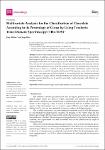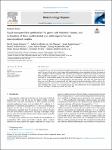Mostrar el registro sencillo del ítem
Application of machine Learning in the discrimination of citrus fruit juices: uses of dielectric spectroscopy
| dc.contributor.author | Chuquizuta Trigoso, Tony | |
| dc.contributor.author | Oblitas Cruz, Jimy | |
| dc.contributor.author | Arteaga Miñano, Hubert | |
| dc.contributor.author | Castro Silupu, Wilson | |
| dc.date.accessioned | 2021-06-21T17:18:57Z | |
| dc.date.available | 2021-06-21T17:18:57Z | |
| dc.date.issued | 2020-11-17 | |
| dc.identifier.citation | Chuquizuta, T. ...[et al]. (2020). Application of machine Learning in the discrimination of citrus fruit juices: uses of dielectric spectroscopy. IEEE Engineering International Research Conference (EIRCON), 1-4. https://doi.org/10.1109/EIRCON51178.2020.9253756 | es_PE |
| dc.identifier.uri | https://hdl.handle.net/11537/26913 | |
| dc.description | El texto completo de este trabajo no está disponible en el Repositorio Académico UPN por restricciones de la casa editorial donde ha sido publicado. | es_PE |
| dc.description.abstract | ABSTRACT Nowadays, process control in the juice industry requires fast, safe and easily applicable methods. In this regard, the use of dielectric spectroscopy is being coupled to statistical methods such as machine learning in order to develop new methods to identify adulteration. However, there is a small number of scientific reports above the application of the aforementioned methods when citric fruit juices is being identified. Therefore, the objective of this research was to evaluate dielectric spectroscopy and four different classification techniques (Support Vector Machine - SVM, K-nearest neighbor-KNN, Linear Discriminat -LD and Quadratic Discriminat-QD) to discriminate between three citrus juices. For this purpose, samples of Citrus limetta, Citrus limettioides and Citrus reticulata were evaluated; obtaining its dielectric spectral profiles in the range of 5 to 9 GHz. Then from the spectral profiles the loss factor (e”) was calculated using the reflection coefficient. Next e” value was pretreated, reducing noise through a savitzky golay filter, and new variables created through Principal Component Analysis (PCA). Finally, the models for classification were constructed with the previously mentioned techniques and the principal components. The results shown that using four components the variance can be explained in 97%; likewise, the discrimination values vary between 88.9 and 100.0%, with SVM, LD and QD the best discrimination techniques all successfully at 100.0 %. Therefore; It is concluded that the technique of dielectric spectroscopy and machine learning presents potential for the discrimination of citrus fruit juices. | es_PE |
| dc.format | application/pdf | es_PE |
| dc.language.iso | eng | es_PE |
| dc.publisher | IEEE | es_PE |
| dc.rights | info:eu-repo/semantics/openAccess | es_PE |
| dc.rights | Atribución-NoComercial-CompartirIgual 3.0 Estados Unidos de América | * |
| dc.rights.uri | https://creativecommons.org/licenses/by-nc-sa/3.0/us/ | * |
| dc.source | Universidad Privada del Norte | es_PE |
| dc.source | Repositorio Institucional - UPN | es_PE |
| dc.subject | Jugos de fruta | es_PE |
| dc.subject | Ingeniería de la producción | es_PE |
| dc.subject | Industria alimentaria | es_PE |
| dc.title | Application of machine Learning in the discrimination of citrus fruit juices: uses of dielectric spectroscopy | es_PE |
| dc.type | info:eu-repo/semantics/conferenceObject | es_PE |
| dc.publisher.country | PE | es_PE |
| dc.identifier.journal | IEEE Engineering International Research Conference (EIRCON) | es_PE |
| dc.subject.ocde | https://purl.org/pe-repo/ocde/ford#2.11.04 | es_PE |
| dc.description.sede | Cajamarca | es_PE |
| dc.identifier.doi | https://doi.org/10.1109/EIRCON51178.2020.9253756 |
Ficheros en el ítem
| Ficheros | Tamaño | Formato | Ver |
|---|---|---|---|
|
No hay ficheros asociados a este ítem. |
|||





